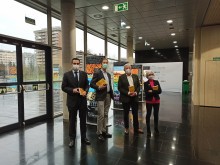Related news by tag Science in the Basque Country
Donostia – San Sebastián, a city of (nano) science and technology
The beauty, gastronomy and cultural life of San Sebastian are some of the most outstanding assets of our small city. Nevertheless, following the last virtual issue in ACS nano, San Sebastian also stands as a city of science and technology, specially devoted to the nanoscience field. The present work highlights the contribution of the nanoscience community of San Sebastian to nanoscience and technology.
As described in the editorial of this issue, some of the main representatives of the nanoscience community in San Sebastian stand together, namely, the Nanoscience Cooperative Research Center (CIC nanoGUNE), the Donostia International Physics Center (DIPC), the Basque Center for Macromolecular Design and Engineering (Polymat), the Center for Cooperative Research in Biomaterials (CIC biomaGUNE), the Technology Centers Cidetec, CEIT, and Tecnalia, and the Health Institute Biodonostia along with the Centro de Física de Materiales (CFM), a joint initiative of the University of the Basque Country (UPV/EHU) and Consejo Superior de Investigaciones Científicas (CSIC).
This research force has contributed considerably to ACS Nano with more than 100 publications during the past decade, some of which have already had significant impact and are highlighted in this virtual issue.
As reported by the authors “This collaborative work has been combined with our commitment toward industrial development of nanotechnology both locally and worldwide, which has led not only to an increase in top-notch industrial research in our community but also to the launch of a number of promising nanotechnology-based start-up companies”.
The entities highlighted above, express they are confident that, with the continuous and synergetic support from Spanish and Basque authorities, the research activity in the area of nanoscience and nanotechnology will continue to flourish in our beautiful city.
NanoGUNE, the big challenge of the small
“NanoGUNE has succeeded in making a place for itself in the network of international science. When nanoGUNE was inaugurated in 2009, we were facing an enormous challenge, and today we are proud because that challenge is being met,” said Jose Maria Pitarke, nanoGUNE’s CEO.
The nanoscience and nanotechnology festival due to be held this year in Bergara
For a third year CIC nanoGUNE is coordinating the organising in Gipuzkoa of the festival designed to bring nanoscience and nanotechnology closer to the general public: 10ALAMENOS9. This year, the agreement signed between nanoGUNE and Bergara Town Council means that the various activities will be taking place at the Museo Laboratorium in Bergara. A number of cities will be hosting the festival in March and April: Zaragoza, Madrid, Valencia, Barcelona and Bergara.
The10AlaMenos9 nanoscience and nanotechnology festival aims in a straightforward, fun way to bring all sectors of the public closer to the nanometric scale and its effects. In the various activities organised for this purpose (exhibition, workshops and lectures), visitors will be delving into the amazing nano world, in other words, the world of small things, of one billionth (10-9, 10 to the power of minus 9) of a metre, a size slightly bigger than atoms and molecules; the size of our DNA.
The full programme of the festival will be presented at 18:00 hours tomorrow, Friday, at the Museo Laboratorium. The following people will be participating in the ceremony: the Ikerbasque researcher Luis Hueso and communications officer Itziar Otegui on behalf of nanoGUNE; Sabino Azkarate, Chair of the Economic Development and Tourism Commission and Maite Agirre, Chair of the Culture and Heritage Commission on behalf of Bergara Town Council.
The participants will then have the chance to visit the exhibition Un paseo por el nanomundo (A Walk through the Nanoworld) guided by Luis Hueso.The exhibition will be presenting authors, tools and works relating to nanoscience and nanotechnology. The images have been captured by amazing tools that have been turned into the “eyes of the nanoworld”. The participants will also be able to see some of the tools used in this field and actual products used in research on a day-to-day basis, such as graphene.

